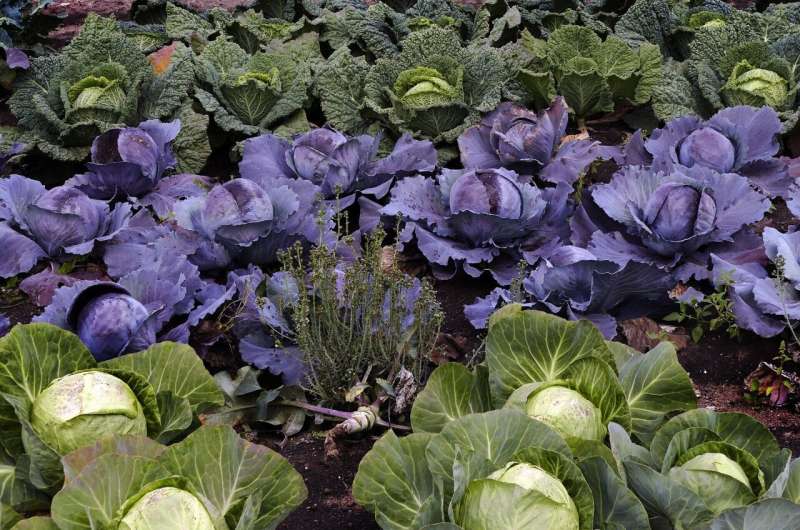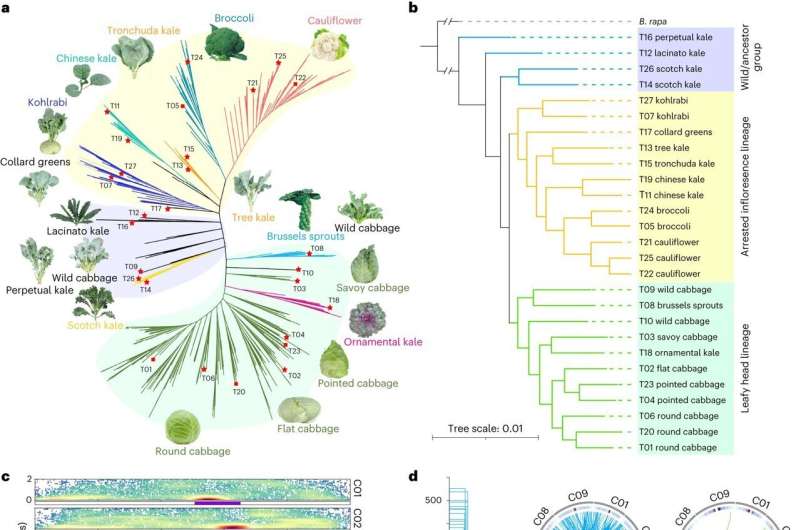This article has been reviewed according to Science X's editorial process and policies. Editors have highlighted the following attributes while ensuring the content's credibility:
fact-checked
trusted source
proofread
Scientists discover 'jumping genes' determine cabbage's exterior

The genetic differences between pointed cabbage and cauliflower are greater than those between humans and chimpanzees. Nevertheless, they are considered the same species. Researchers from Wageningen and China mapped the extensive genetic variation of cabbage (Brassica oleracea) to enable more targeted breeding, for example, to create crops with a higher nutritional value or that are more resilient against disease. The study is published in Nature Genetics.
Brassica crops make up a significant portion of our menu. There is considerable variation. Still, cauliflower, broccoli, brussels sprouts, red cabbage, white cabbage, pointed cabbage and kohlrabi are all variations of the same species, Brassica oleracea. How can there be such diversity within a single species?
The variation goes beyond the exterior. Content, such as vitamins, antioxidants and resilience against drought, cold and disease, also differ widely.
The genome, the genetic information as a whole, was already quite well-known, but how the variation within the genome related to the diversity in vegetables was unclear.
International collaboration
Researchers of Wageningen University & Research and the Chinese Academy of Agricultural Sciences in Beijing joined forces to determine the DNA sequence of 23 different cabbage crops and analyzed these along with the existing genome data.
"We constructed a so-called pan-genome: an overview of all the different genes within the various cole crops. We then went on to determine which genes occur in most of the crops and which are unique to a particular crop type," says Guusje Bonnema, plant breeding researcher at Wageningen University & Research. In recent years, she has worked intensively on the research from the Netherlands with fellow researcher Chengcheng Cai.
The results were surprising: only one-third of the genes occur in all of the brassica crops, and half of the genes occur in only part of the crops and are absent in the rest.
"B. oleracea has many genes. Cauliflower, for example, has some 60,000 genes, compared to humans who have only 20,000. This is due to the fact that the genome tripled some 15 million years ago, while the original genome was already sufficient to enable the plant to function successfully. We aim to understand what prompted the variation so that we can breed to create better varieties," Bonnema clarifies.

Jumping genes
More than half of the genome is made up of transposons, which are small pieces of DNA that "jump around" within the genome and, hence, may appear in any number of places within it. These transposons are known as "jumping genes" in the Netherlands. They have a bad reputation in humans for causing diseases such as hemophilia. In plants, however, they form a crucial source of natural variation.
"We discovered that the transposons frequently regulate the activity of genes in their vicinity by increasing or decreasing the activity levels. Previously, we were looking for the uniquely defining genes that determine what makes a cauliflower a cauliflower. Now we know that you must find not only the genes but also their operators. The transposons, in this case. They are the on/off switches and regulators of the genes that are in their vicinity," she says.
Breakthrough in insight
The fact that there is now a pan-genome (an overview of all the different genes in the species) available enables scientists to categorize the transposons and other variations in structure.
"These transposons drive the genes' activities, and not just the genes that determine the specific appearances of the various brassica vegetables, but also those that determine resistance, flavor and nutritional value as well as resilience against climate conditions. Cauliflower, for example, is very temperature-sensitive. Understanding the process behind this sensitivity facilitates breeding varieties that are less sensitive to temperature," Bonnema explains.
"This is a genuine breakthrough in insights. We were always focused on variations within the genes, but we now know that reality is much more subtle. Gene activity regulation has an enormous influence."
More information: Xing Li et al, Large-scale gene expression alterations introduced by structural variation drive morphotype diversification in Brassica oleracea, Nature Genetics (2024). DOI: 10.1038/s41588-024-01655-4
Provided by Wageningen University




















